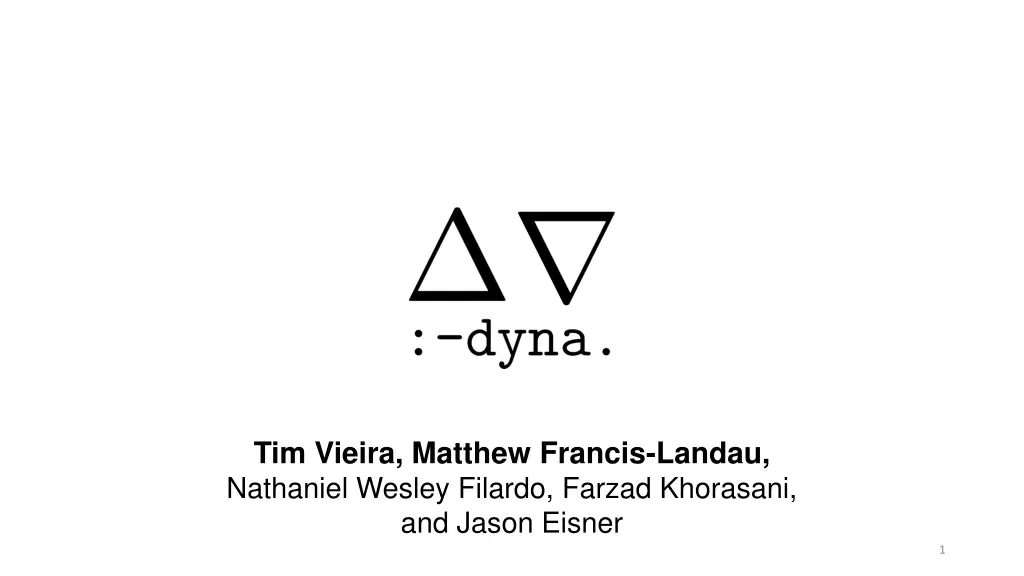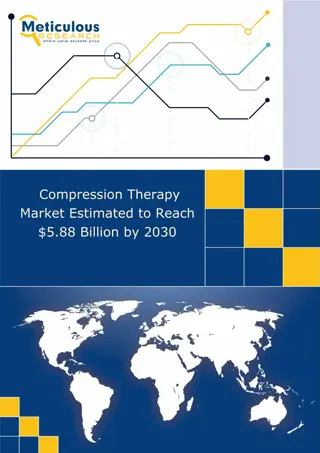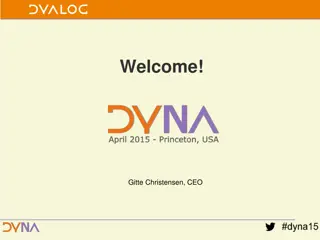
Declarative Programming and Dyna Language Overview
Explore the concepts of declarative programming and the Dyna language for machine learning applications. Learn about the benefits of automatic program optimization, the differences from traditional programming languages, and why declarative programming is essential in optimizing efficiency for ML algorithms.
Download Presentation

Please find below an Image/Link to download the presentation.
The content on the website is provided AS IS for your information and personal use only. It may not be sold, licensed, or shared on other websites without obtaining consent from the author. If you encounter any issues during the download, it is possible that the publisher has removed the file from their server.
You are allowed to download the files provided on this website for personal or commercial use, subject to the condition that they are used lawfully. All files are the property of their respective owners.
The content on the website is provided AS IS for your information and personal use only. It may not be sold, licensed, or shared on other websites without obtaining consent from the author.
E N D
Presentation Transcript
Tim Vieira, Matthew Francis-Landau, Nathaniel Wesley Filardo, Farzad Khorasani, and Jason Eisner 1
Dyna: Dyna: Toward a Self-Optimizing Declarative Language for Machine Learning Applications Faster execution ML PL Faster to implement 2
Outline Why Declarative Programming? Quick introduction to the Dyna language ML PL Automatic optimization of Dyna programs ML PL 3
Declarative Programming Declarative Programming A programming paradigm where the programmer specifies what to compute and leaves how to compute it to a solver. Examples: SQL, Prolog/Datalog, Mathematica, Regex, TensorFlow/Theano Solver seeks an efficient strategy (e.g., SQL query planning) 4
Why declarative programming? Many ML algorithms have a concise declarative program There are many choices to make when writing a fast program Loop orders Data structures (e.g., hash map, dense array, linked list) Global execution strategy (e.g., depth vs. breadth-first search) Parallelization opportunities Manually experimenting with all possibilities is time consuming Programmers usually only implement one Researchers don t have time to optimize the efficiency of their code We can do better with automatic optimization 5
Why not optimize Python/Java/C++ etc.? Less flexibility Choices of loop orders / data structures already decided by the human programmer Semantics of the program are not invariant to Changing execution and loop order Eager vs. lazy evaluation, top-down vs bottom-up evaluation. Data structures Concurrency Difficult to reliably discover long range interactions in a program 6
What is Dyna? Declarative language Based on weighted logic programming Prolog / Datalog like syntax Uses pattern matching to define computation graphs Reactive Dyna programs are close to their mathematical description Similar to functional programs 7
Dyna Day 1 a = b * c. a will be kept up to date if b or c changes. (Reactive) b += x. b += y.equivalent tob = x+y. (almost) b is a sum of two variables. Also kept up to date. c += z(1). c += z(2). c += z(3). c += z("four"). c += z(foo(bar,5)). a patterns the capitalized N matches anything c += z(N). c is a sum of all defined z( ) values. 8
More interesting use of patterns a(I) = b(I) * c(I). pointwise multiplication a += b(I) * c(I). dot product; could be sparse a(I,K) += b(I,J) * c(J,K). matrix multiplication; could be sparse J is free on the right-hand side, so we sum over it 9
Dyna vs. Prolog Prolog has Horn clauses: a(I,K) :- b(I,J) , c(J,K). Dyna has Horn equations : a(I,K) += b(I,J) * c(J,K). definition from other values b*c only has value when b and c do if no values enter into +=, then a gets no value prove a value for it e.g., a real number, but could be any term Like Prolog: Allow nested terms Syntactic sugar for lists, etc. Turing-complete Unlike Prolog: Terms can have values Terms are evaluated in place Not just backtracking! 10
Shortest path Note: Aggregation was already present in our mathematical definition. distance(X) min= edge(X, Y) + distance(Y). distance(start) min= 0. path_length := distance(end). After this converges we can query the state of the Dyna program. edge("a", "b") = 10. edge("b", "c") = 2. edge("c", "d") = 7. edge("d", "b") = 1. start = "a". end = "d". product example. Here the min= aggregator only keeps the minimal value that we have computed other vertex than 7 away All of the edges leaving "a" Variables not present in the head of an expression are aggregated over like with the dot ? edge("a",X) ? path_length ? distance("c") ? distance(X) ? distance(X) > 7 All of the vertices The distance of some All the vertices more Length at the end 11
Aggregators Associative/commutative: b += c max= a(X). q |= r &= Choose any value: e ?= b. e ?= c. User definable aggregators a(X) smiles= b(X, Z). (Just define all of the operation of an commutative semigroup) a(X). % number p(X). % boolean p(X). Require uniqueness: d = b+c. Last one wins: fly(X) := true if bird(X). fly(X) := false if penguin(X). fly(bigbird) := false. 12
Neural Convolutional Layer Learned Some Convolution output Convolution output Input image feature weights nonlinearity Input image 13 http://deeplearning.stanford.edu/wiki/index.php/Feature_extraction_using_convolution
Neural Convolutional layer We can easily define rules over activation(I, J) += input(I + M, J + N) * weight(M, N). hidden(I, J) := (activation(I, J)). ?(X) := 1 / (1 + exp(-X)). weight(DX,DY) := random(*,-1,1) for DX:-1..1, DY:-1..1. Here keys are integers but we can also support more Our ranges over ? Summation became an aggregator complicated structures and ? are reflected in the shape of weight 14
Note: nowhere in this program do we specify the form of our variables I, J the structure of keys inside the definition of edge. More Neural Instead we can specify ?(X) = 1 / (1 + exp(-X)). out(J) = (activation(J)). activation(J) += out(I) * edge(I,J). The output of a neuron is our nonlinearity applied All weights have been rolled into the edges connecting neurons edge(input(X,Y),hidden(X+DX,Y+DY)) = weight(DX,DY). weight(DX,DY) := random(*,-1,1) for DX:-1..1, DY:-1..1. to the sum of its inputs The weight do not depend on the absolute location of the input, so this is a convolution again. 15
Dyna Makes Algorithms Easy Gibbs, MCMC flip variable, compute likelihood ratio, accept or reject Iterative algorithms loopy belief propagation, numerical optimization Neural networks computation graphs passing dense matrices Branch-and-bound, Davis Putnam Logemann Loveland (DPLL) Implementations and more in: Dyna: Extending Datalog for modern AI. (Eisner & Filardo 2011) Dyna: A non-probabilistic language for probabilistic AI. (Eisner 2009) 16
How much can a declarative language save us? 17
Implementing shortest path Dyna (Declarative) Java (Procedural) placeIndex = new HashMap<String,Integer>(); edges = new float[num_places][num_places]; // load edges float distance(from) { if(from == placeIndex.get("start")) { return 0; } l = edges[from]; r = infinity; for(j = 0; j < l.length; j++) { n = distance(j) + l[j]; if(n < r) r = n; } return r; and bidirectional search, and choice of data structures to placeIndex = new HashMap<String,Integer>(); queue = new PriorityQueue<Integer, Float>(); distances = new float[num_places]; edges = new float[num_places][num_places]; // load edges queue.push(placesIndex.get("start"), 0); while(!queue.empty()) { d = queue.pop(); l = edges[d.first()]; for(j = 0; j < l.length; j++) { n = d.second() + l[j]; if(distances[j] < n) { distances[j] = n; queue.push(j, n); } } } path_length = distance(placeIndex.get("end")); queue = new FifoQueue<Pair<String, Float>>(); distances = new HashMap<String, Float>(); edges = new HashMap<Pair<String, String>,Float>(); // load edges queue.push("start"); while(!queue.empty()) { d = queue.pop(); for(e : edge) { if(e.first().second().equals(d.first())) { if(distance.get(e.first()) < d.second() + e.second()) { distance.put(e.first(), d.second() + e.second()); queue.push(e.first()); } } } } path_length = distances.get("end"); queue = new PriorityQueue<String, Float>(); distances = new HashMap<String, Float>(); edges = new HashMap<Pair<String, String>,Float>(); // load edges queue.push("start", 0); while(!queue.empty()) { d = queue.pop(); for(e : edge) { if(e.first().second().equals(d.first())) { n = d.second() + e.second(); if(distance.get(e.first()) < n) { distance.put(e.first(), n); queue.push(e.first(), n); } } } } path_length = distances.get("end"); queue = new PriorityQueue<String, Float>(); distances = new HashMap<String, Float>(); edges = new HashMap<String,Map<String,Float>>(); // load edges queue.push("start", 0); while(!queue.empty()) { d = queue.pop(); for(e : edge.get(d.first())) { n = d.second() + e.second(); if(distance.get(e.first()) < n) { distance.put(e.first(), n); queue.push(e.first(), n); } } } path_length = distances.get("end"); } path_length = distances[placeIndex.get("end")]; support dynamic graphs distance(X) min= edge(X, Y) + distance(Y). distance(start) min= 0. path_length = distance(end). A single Dyna program can represent hundreds of possible implementations. Other implementations (not shown here) include A* 18
Given all of these implementations, the problem is choice The Matrix Reloaded (2003) 19
If you are Neo, you have two choices Take the Architect s deal Restart the Matrix Let all the humans in Zion die But restart Zion with 16 females and 7 males (fight another day) Already tried this 5 times Current argmax Follow an emotion specifically designed to overwhelm logic & reason Save Trinity YOLO, figure this out as we go (unknown reward) 20
This raises the next question can machines love or at least make irrational choices The Rational Choice The Irrational Choice (Randomly sample) Exploration Exploitation 21
Outline Why Declarative Programming? Quick introduction to the Dyna language ML PL Automatic optimization of Dyna programs ML PL 22
Dyna query response output output = 2 Dynamic data structure update input("b") := 0 response query output = 1 output compile Dyna source code (micro-example) output max= input(I). input("a") := 1. input("b") := 2. 23
Tuning Dyna Solver has knobs to tune update Dynamic data structure response (via callback) Workload I query Optimizer latency Total cost knob setting Average latency on workload Encourage earlier jobs to finish first Example knob: eager or lazy updates? e.g., dynamic max data structure urgency % Dyna: output max= input(I). Max-heap: O(log n) per update O(n) per batch update ( heapify ) knob settings 24
Off-line training Slow! Run entire workload Fiddle with knobs Feedback Reasonable way to tune knobs off-line (used by PhiPac, ATLAS, SATZilla) Open up the solver The inefficiency: this loop explores one policy per run. How do we tighten the loop to get feedback more often?
% matrix multiplication c(I,K) += a(I,J) * b(J,K). Tasks on agenda can be executed in any order! Interpolates between eager and lazy strategies Inside the solver Task: Compute c(I,4)for all I choose! pop Tons of admissible strategies. Each attempts to make progress toward an answer to open queries queries & updates task agenda Memos are optional. Solver can create or flush memos anytime. (memos save recomputation, but require maintenance) Strategy: for J in b(:,4): for I in a(:,J): c(I,4) += a(I,J) * b(:,4) run new tasks strategy choose! memoize computed values response cache lookup thread 26
Strategy options Solver should systematize all the reasonable implementation tricks that programmers might use and make them work together correctly. Parallelizing independent computations Ordering dependent computations Join strategies Forward vs. backward chaining (update-driven vs. query-driven) Dynamically identify unnecessary computation Short-circuiting, branch-and-bound/A*, watched variables Consolidating related work Static or dynamic batching (consolidating similar tasks, including GPU) Inlining depth (consolidating caller-callee) Storage Memoization policy; choose low-level data structures Many strong interactions among decisions 27
The Dyna solver Lots of challenges in defining this giant space while preserving correctness Most systems avoidchoices. We embrace choice because we have machine learning to choose intelligently. Further reading Mixed-chaining / arbitrary memoization (Filardo & Eisner, 2012) Set-at-a-time inference (Filardo & Eisner, 2017, in preparation) Lots of progress to come! Nathaniel Wesley Filardo is tying up many loose ends in his thesis (September 2017) He s on the job market! 28
Sequential choices at runtime (some stochastic) edge( ) query query edge(x,Y) for some for some x answer from edge rules using join strategy 1 join strategy 2
Sequential choices at runtime (some stochastic) edge( ) query query edge(x,Y) for some for some x hash hash(x)/H 0.2 0.2 answer will be an iterator over outgoing edges (adjacency list) z look up answer in dense array A4 indexed by x (where x is an integer or is represented as one) look for answer in sparse hash table H5 cached cached return answer ` answer from edge rules using join strategy 1 query edge(X,Y) and filter to X=x join strategy 2 Policy probabilities that are tuned over time (typically approaching 0 or 1) return answer memoize & return
Policy probabilities can be sensitive to context of task Stochastically conditioned on the following information (features). Task characteristics - What type of task? - What are the task parameters? - Who requested the task? Dataflow - What depends on this task (children)? - What does this task depend on (parents)? Agenda characteristics - Are there a lot of open queries? - What s on the agenda? How long has it been there? Cache characteristics - Statistics: number, hit rate, frequency, & recency of memos (broken down by type) 31
Tuning probabilities query edge(X,Y) and filter to X=x If we knew the long-term cost of each action in context, we could update the policy now! return answer memoize & return hypothetically, fork state and run finish workload Generalize from past experience to new situations Slow! Use ML to predict future costs! 32
Temporal difference learning Approximate dynamic programming Make estimator agree with itself
Actor-critic policy gradient Says increase the probability of lower cost actions. update q
Summary Declarative languages lend themselves to automated optimization because their solvers have a lot of freedom. Tuning such as solver is a sequential decision making problem that can be tuned with online reinforcement learning techniques. Dyna Has been designed from the ground up be as flexible as possible. A powerful language for specifying machine learning applications. Check out the paper! Lots of great technical details in the paper that didn't have time to get into. 35
State of the language We have to two language prototypes Dyna 1 prototype (2005) was used in Jason s lab, fueling a dozen NLP papers! Dyna 2 prototype (2013) was used for teaching an NLP course to linguists with no programming background. Both were inefficient because they used too many one-size-fits-all strategies.
Thanks! Questions? Comments? http://dyna.org @xtimv @matthewfl Hire Wes Filardo! http://cs.jhu.edu/~nwf
Dont do and even wait until all of Join strategies Outer loop on b(J,4), inner loopa(I,J) Outer loop on a(I,J), inner loop b(J,K),filter K==4 Sort a and b on J and use Baeza-Yates intersection What if we can t loop over b? e.g., b(I,K) = X*Y. In natural language parsing with the CKY algorithm, an unexpected loop order turned out to be 7-9x faster than the loop order presented in most textbooks because of cache locality (Dunlop et al. 2010). % matrix multiplication c(I,K) += a(I,J) * b(J,K). 41
Dont do and even wait until all of Memoization and data structures Do we store results for future use? (tradeoff: memos must be kept up-to-date!) What data structure? 42
Dont do and even wait until all of Batching, answering bigger queries/updates Batch pending c queries. Preemptively compute a broader query, c(I,K) Use clever mat-mul alg. (sparse or dense?) 43
Dont do and even wait until all of Inlining Inline a and/or b queries. Bypass agenda and route directly to consumer, e.g., d(I) max= c(I,K). Reduce overhead of method calls Reduce overhead of task indirection through agenda 44
Mixed policies Mixed task strategies selection Policy will encounter similar tasks frequently Mixed storage strategies e.g., use a hash table, prefix trie, dense array, Problem: random choice of strategy might not be consistent E.g. might write to A and read from B (because of randomness) 45
Implementations? Implementations? Hash cons, trie (different orders on keys), dense vs. sparse, sorted (what to sort on) Storage key edge("a", "b") = 1. edge("b", "c") = 2. edge("c", "d") = 5. pathCost("a", "d") = 8. pathCost("a", "c") = 3. Name of map Named maps key -> value value Queries Efficiency depends on - Frequency of different queries - Overhead of read/writes - Sizes - Lower-level thresholds ? edge("a","b") ? edge("a",Y) ? edge(X,"b") ? edge(X,Y) ? edge(X,X) ? edge(X,Y) >= 10 What s the weight of edge a->b Outgoing edges from a Incoming edges to b List all edges List all self loops Edges with weight >= 10 46
Mixed storage solution :any edge(:any,:any) pathCost(:any,:any) edge(:str,:str) edge(:int,:int) edge("a",:str) Small, temporary data duplication hash(edge("a", "b")) / 2^32 ~ Uniform(0,1) Trie 1->2 Trie 2->1 Hash table 47
Learning to choose a good strategy 1. Bandit: Each time we execute a task (e.g., compute c(I,j) for an argument j): Randomly try one of the available strategies (explore) according to some probability distribution Bias this distribution in favor of strategies with lower measured cost (exploit). 2. Contextual bandit: Allows distribution to depend on task arguments (e.g., j) and solver state. 3. Reinforcement learning: Accounts for delayed costs of actions. queries & updates choose! pop task agenda run new tasks strategy choose! memoize computed values response cache lookup thread 48
Back to online training Run entire workload Fiddle with policy Feedback
Solver Actions Workload Policy actions
Rewrite the objective function Workload i Actions t Rewrite in terms of the policy s time scale (used in RL) Each step tries to decrease the load TODO inline in parens use underbrace to give it a name Add Jason integral picture?










